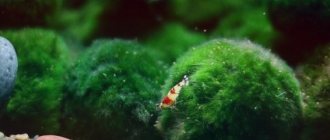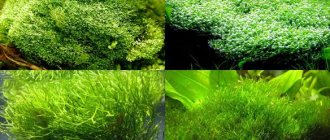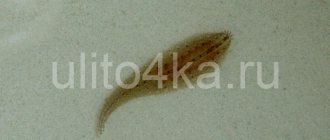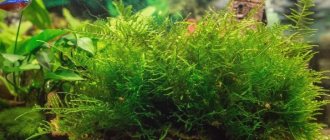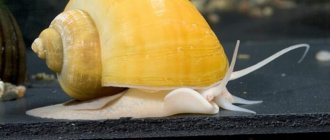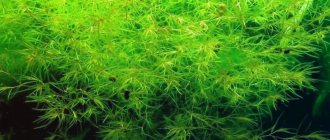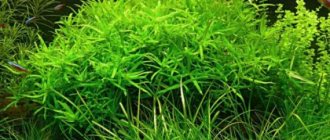Cladophora globose, also known as Linnaeus' aegropile. Its homeland is Japan and Iceland, but due to its high endurance, its range has spread throughout the northern hemisphere in fresh water bodies.
The name of the organism changed several times, but since 2002, “Aegagropyla Linnaeus” has stuck in honor of the scientist who first described it.
This algae will not only decorate the appearance, but will also help improve conditions, acting as a natural filter.
Table of basic maintenance and care parameters:
| What should be the temperature in the aquarium? | from +20-22 °C, when increased, the algae begins to lose shape and disintegrate |
| What is the pH | from 6.5-7 pH |
| What should the water hardness be? | 6-8 °dH |
| What should the substrate be? | any |
| What kind of lighting should there be? | moderate |
| Maximum height | 4-5 mm per year. Under natural conditions, the diameter reaches from 12 to 30 cm, in an aquarium - 6-8 |
| Growth rate | slowly |
| Content complexity | unpretentious |
What aquariums is it suitable for?
Cladophora is perfect for any type of aquarium; it does not attach to the soil, so the decorative effect of the plant will depend only on the volume of the aquarium and the number of cladophora balls in it.
Therefore, this plant is often placed in a spawning tank where fry grow. For them, cladophora will simultaneously be a source of oxygen and natural food.
Cladophora looks great in aquariums that imitate natural bodies of water.
Appearance and description of spherical cladophora
The “body” of the algae has a rounded shape, resembling a ball, which consists of branching threads. With the help of rhizoids it is attached to the surface of the substrate or any decorative element. Due to its special structure, cladophora moves freely with the flow of water, and photosynthesis occurs without obstacles.
The “green ball” grows slowly, by about 4-5 mm per year. Under natural conditions, the diameter reaches from 12 to 30 cm, in an aquarium - 6-8. Contrary to the opinion that a “blooming” aquarium is unacceptable, cladophora does not spoil it. It has the ability to pass a large amount of water through itself, thereby purifying it. Moreover, the aegropile is suitable as an unusual decoration. If you cut it, you can get a nice green mat on the bottom of the aquarium.
Description
It is very easy to distinguish this aquarium plant from others - the green balls of Aegagropyla Linnaeus immediately catch the eye due to their round shape.
Some believe that cladophora is moss in the form of balls. But this is not so - this plant is classified as algae. One ball contains a large number of plants that actively release oxygen. Also, the cladophora ball is a living sponge that actively absorbs the waste products of aquarium fish and acts as a kind of filter.
Another useful quality of this algae colony is that over time, beneficial bacteria appear on the plant, which are able to process nitrate and phosphate compounds from the water . Cladophora must be placed in a newly purchased aquarium (or when restarting). After all, freshly filled tap water does not contain all the minerals necessary for keeping fish, and cladophora is perfect for enriching it with minerals.
Cherries happily explore the cladophora in search of food.
The ball is also suitable for aquariums containing fry and/or shrimp. They happily eat particles of food that linger on the surface of the Aegagropile. And these small algae themselves will be an excellent food for the inhabitants of aquariums.
Cladophora balls are dark emerald in color, they consist of small thin filamentous algae. The plant is extremely unpretentious, so it can grow naturally in almost any conditions - in rivers or lakes.
The plant can be cut into pieces, creating various compositions from them, creating a kind of cladophora mat, similar to a ground cover.
Many novice aquarists consider Cladophora a type of moss, but this is wrong. The outside of this plant consists of thin algae, and inside the ball there are already dead parts of them, which, like sponges, can absorb any particles floating in the water.
Cladophora in section.
Maintenance and care
Like all algae, Cladophora does not have a root system, so the soil is completely unimportant for it. Any will do. This unpretentious plant can be kept in aquariums of various sizes. But you need to be more careful about other requirements:
- Temperature. In its natural environment it lives in cool water bodies. The indicator should not exceed +20-22° C; as it increases, the algae begins to lose its shape and disintegrate.
- Acidity from 6.5-7 pH.
- Hardness from 6-8° dH.
- The lighting is moderate, cladafora is adapted to the lack of light. When there is an excess of it, air bubbles appear inside the colony and the plant floats to the surface. The bright green color becomes pale.
- Accommodation. Preferred areas are in partial shade, under driftwood or broad-leaved plants.
- To ensure that the algae does not lose its appearance and feels good, high-quality filtration and regular washing are necessary.
- Once a week, change the water by ¼ of the total volume.
A problem for Aegagropyla Linnaeus can be other types of algae that settle on them. The solution would be to get rid of it mechanically. Inhabitants such as goldfish, crayfish, plecostomus and others will become a real threat.
The decorative effect of globular algae can be increased by giving it different shapes. With its help they make a soft island. To do this, you need to cut a fluffy ball, cover any stone with it and tie it with fishing line. Another useful use is for individual fry tanks. Single-celled organisms that accumulate inside will become ideal food in the first days of life.
In an aquarium with elevated temperatures, cladophora lives for 1-1.5 months, then disintegrates.
In its natural environment it lives at a depth of 30 m. It can remain without water for a long time.
Nutrition occurs through photosynthesis.
Caring for Cladophora globulus
Over time, plaque forms on the balls as a result of the vital activity of aquatic organisms. In this case, they are taken out of the aquarium and washed with running water. It is not recommended to squeeze the ball too hard, as this can slow down its growth and deform its structure.
The aegropile may change color, which is a sure sign of a problem:
- If the color has faded, it means that the lighting is very strong and to restore the ball you need to move it to a dark place.
- Pallor or yellowing on one side is a lack of light. You should turn the seaweed over to the other side.
- If it turns brown, the level of organic pollution is too high. The ball is washed in water or temporarily placed in a container with lightly salted water.
If the cladophora is spherical, then the dead fragments begin to rot and turn black, so they are removed from the aquarium. And healthy pieces will give rise to a new colony.
Reproduction of Cladophora in an aquarium
If you like the algae and have enough space, you can start breeding it without any problems. You just need to divide the colony and place it in a separate container. As mentioned above, this is facilitated by an increase in temperature. There is another option - cut with scissors. Having created the necessary conditions, the plant will begin to grow, albeit not quickly.
Cladophora also reproduces asexually, forming zoospores. The cell floats freely for some time, then the flagella on it fall off and a dense shell appears. This is how a new organism is born.
Name
Spherical cladophora (lat. Cladophora aegagropila) is an outdated name, which, however, is widely used in the literature and among most aquarists. Since 2002, the plant began to be called Aegagropila linnaei.
The unusual algae also has popular names: ball moss, moss ball. The Japanese gave her the nicknames marimo (“plant ball”) and “lake ghost.”
Varieties of Cladophora (Cladophora green)
Aegagropyla Linnaeus has a relative in the family, a filamentous algae. Its appearance in the aquarium is extremely undesirable, and its removal causes certain difficulties. It develops quickly, covering aquarium plants, and attaches to the substrate. Within a couple of days, the parasitic plant spreads throughout the entire aquarium. “Green beard” is often confused with spherical beard. Symptoms of appearance: at first, the branched threads are invisible. They then form a bundle, which is attached to the substrate at one point. The short, dark green algae remains rough and rough to the touch when out of water. If you rub them between your fingers, you can feel a specific smell.
Typically, these plants are introduced into the aquarium along with new plants or fish. Also, green beard can be carried with spherical algae.
Living in the wild
Cladophora globulus is a type of algae that resembles moss in appearance. Other names for the plant are moss ball, lake moss, and its scientific name is Linnaeus' aegropylus. In Japan, Cladophora is known as marimo, which translates to “bouncy ball.”
In the wild, the algae grows in water bodies of Asia, Europe, Japan and Iceland. Cladophora feels great and reproduces in clean, fresh and cool waters of rivers and lakes at a depth of 2–3 meters, where the water temperature is from 18C to 24C. Thanks to the slow flow, the spherical cladophora acquires a rounded shape, rolling along the bottom.
The ability of lake moss to move allows the plant to constantly synthesize organic components, which makes the plant independent of the type of soil. In the morning and afternoon, the moss ball rests calmly at the bottom, and in the evening it floats at the surface of the water. The change in location occurs due to the accumulation of air bubbles, causing the algae to rise upward. If you get rid of them, the plant will go down again.
Cladophora globulus is not a higher aquarium plant, but a type of algae that has become popular among pond owners due to its unusual shape and ability to purify water.
Harm from Cladophora (filaments)
Its presence is accompanied by the release of a large amount of waste into the water. The uninvited guest fills the walls of the aquarium and decorations, tubes and hoses, grows into the ground, not to mention causing significant harm to plants.
Young fish become entangled in these algae. Stuck food between thin threads causes rotting, which will lead to the death of the biological system if measures are not taken in time.
Sometimes the appearance of filamentous algae indicates a deterioration in living conditions: insufficiently clean water, low oxygen content, or changes in parameters.
Ways to deal with bad cladophora
The filament is the most difficult to remove. Do not use the mechanical method (manually). So it will grow even more: each broken off bundle is capable of life, it forms a new organism.
Changing environmental conditions only has a detrimental effect on living plants, since their maintenance requires the same indicators.
The green beard does not like strong currents; in them it grows slowly. To get rid of it, you need to ensure good water circulation. Avoid stagnation zones. Sometimes it is enough to install an additional filter and direct the flow of water to the fireplace.
Biological method - Amano shrimp. Ideally, use young and hungry individuals. There should be at least 30 crustaceans per 100 liters.
There is another way - chemical. It can be dangerous for other inhabitants. In such a situation, spot application of algaecide is suitable so that its dose is the maximum permissible for the aquarium. For this:
- turn off the filter and air compressor;
- Use a syringe to slowly inject the drug into the plant;
- do not make sudden movements so that the water does not mix;
- turn on the filter and aeration after half an hour.
To achieve maximum effect, it is necessary to carry out 5-10 treatments.
Prevention
It is considered normal to have filamentous algae in an aquarium, because they are also part of a healthy biosystem. But an excess of lower plants causes many problems. It is easier to take measures to avoid overgrowth than to deal with pests later.
- ensure good filtration, prevent rotting of food debris;
- avoid exposure to direct sunlight;
- high-quality aeration;
- feeding fish should be moderate, then there will be no excess of waste products;
- When purchasing new plants or pets, be sure to inspect them. It is with them that filamentous algae can enter the aquarium. Spores can survive without light and water for a long time.
Content recommendations
As already noted, one of the key characteristics for which the aegropile is so highly valued by aquarists, in addition to its appearance, is its unpretentiousness. Keeping Cladophora globulus in an aquarium is not particularly difficult and even beginners can do it.
Since Egagropyla is not a specially bred aquarium morph, but an algae of natural origin found in nature, many features of its existence in a home pond are directly related to its habitat in the natural environment.
Cladophora lives at the bottom of a reservoir in its natural environment; it should be placed in the same way in an aquarium.
Under natural conditions, Cladophora prefers to be located at the very bottom of the reservoir, where the sun’s rays practically do not penetrate. That is, the life of the algae passes, if not in complete darkness, then with minimal lighting. Therefore, when placing a plant in a tank, it is best to choose the darkest areas for it. The algae will feel comfortable:
- in the corners;
- behind or under snags;
- in the shade of spreading bushes or directly under their branches.
Due to the fact that Cladophora does not have a root system, it does not need soil. This algae is completely independent of the quality of the soil and its condition. The nature of the substrate does not affect its life.
Water requirements
One of the most important maintenance conditions is the water parameters. In order for the egagropyle to live “happily ever after”, you need to create a comfortable living environment for it. Most aquatic plants can be divided into two groups:
- freshwater;
- saltwater.
The amazing algae Cladophora can be included in both the first and second groups. The inhabitant of predominantly fresh water bodies still prefers brackish water. This is also confirmed by the fact that in the freshwater Japanese Lake Akan, where Cladophora lives, the density of algae colonies increases in places where natural springs with brackish water flow into the reservoir.
This preference also applies when Cladophora exists in the aquarium. The algae thrives in brackish water. Experienced owners of their own “underwater kingdoms” even recommend adding special salt to the water if the plant’s condition deteriorates—it begins to turn brown or yellow, etc.
In general, there are no special requirements for water parameters. The following indicators are recommended for the aquatic environment:
- alkalinity: medium;
- pH value (pH) - close to neutral level;
- hardness: low (maximum 8 degrees, a higher value will result in the death of the plant);
- temperature: plus 20−22 degrees Celsius (maximum 25).
The plant is easy to propagate, because cladophora itself disintegrates in warm water and forms new colonies.
In water that is warmer than desired, the plant can begin to grow rapidly. In addition, overheating can lead to consequences such as the destruction of algae - the balls will simply fall apart. On the one hand, this is a negative impact, on the other hand, the fragments into which the plant is divided can be successfully used for breeding cladophora.
Many aquarists around the world are cultivating Cladophora. This is not surprising - the plant has the highest decorative properties, is able to live in various tanks and is undemanding in terms of keeping conditions. If desired, you can use the pieces of aegropile formed after decay to form new algae colonies.
If increasing the number of plant representatives is not part of the plan, there is a way to “glue” the collapsed ball together. With timely cooling of water to normal, cladophora is able to gradually recover and return to its spherical shape.
Unwanted neighbors
The recommended temperature range excludes the possibility of keeping most varieties of tropical fish in the same tank with cladophora. For this reason, cold-water fish species usually become .
Various inhabitants of the underwater kingdom are very fond of the aegropile. For example, catfish and shrimp love to hide behind “plush” cladophora balls or sit on them. But, despite such addictions, these same creatures are capable of destroying the plant.
It is quite difficult to find fish that do not harm cladophora.
The decorative beauty of this algae compensates for the lack of representatives of aquatic fauna in the aquarium. If you really want to add aquarium animals to Egagropyla, you should approach the choice with the utmost caution. Neighborhood with individuals of plecostomus is certain death for the plant. Goldfish are also unfriendly towards this algae. The category of extremely undesirable neighbors also includes large crayfish, which do not get along not only with cladophora, but also with any aquatic vegetation.
Living clean
Like almost all aquarium inhabitants, Cladophora needs a change of water. In this regard, she is no exception to most representatives of the underwater world. Timely renewal of water is very important, it ensures:
- proper development of algal organisms and their growth;
- reduction in the content of nitrates in water, most of which are located in the bottom layer, where the plant is located half the day.
It is necessary to change the water frequently; cladophora, like a filter, absorbs all the debris in the aquarium.
In addition, changing the water prevents the algae from becoming contaminated, which happens quite often. Egagropil acts as a biological and mechanical water filter. It becomes a real aquarium “garbage collector” - various organic particles get stuck in small mossy cells. The function is useful, but the debris that accumulates on the surface of the plant gradually kills it.
Egagropila loves cleanliness. In addition to changing the water in the aquarium, you need to ensure good filtration and aeration. And, of course, in addition to purifying the water, you should take care of cleaning the algae itself. The plant does not require any special cleansing - just gently rinse it in clean water.
Compatibility with aquarium inhabitants
Due to their love of cool water, green balls are incompatible with most tropical fish.
Cladophora can be kept in an aquarium with catfish and shrimp (they like to sit on top or hide below), but they can also destroy the plant. Goldfish and plecostomus are also undesirable neighbors.
Cladophora balls floating around the aquarium can frighten some inhabitants. Angelfish are alarmists, and at the sight of Aegagropila linnaei they can experience severe stress and die.
Kinds
Aquarists encounter two types of Cladophora:
- Globular (Egagropyla Linnaeus) is a noble plant that is specially placed in the aquarium as decoration. It looks beautiful in water and has a number of useful properties. In appearance it resembles a ball, velvety and soft.
- Stray - it is not specifically placed in the aquarium, but is usually brought along with other plants or on the scales of fish. It consists of hard filaments that float in the aquarium and multiply quickly.
Other species of this plant are not found in aquariums, but are found only in rivers or other bodies of water.
External characteristics
The structure of Cladophora surprises and attracts attention. An even ball of dark green color located in an aquatic environment. The Cladophora plant is woven from filamentous algae that form colonies with radial arrangements. The surface structure is similar to felt. The inner part of the colony becomes empty with age, dying, leaving a semblance of a frame of intertwined elastic threads.
By cutting the ball, you can get an unusual carpet for the bottom area, with the aim of creating a green area under water with moss.
Beneficial features
Cladophora is suitable not only for decorating an aquarium. It can be used as:
- additional source of oxygen. With intense lighting, the plant begins to intensively secrete it;
- natural filter. Traveling along the bottom of the aquarium, the algae passes a significant amount of water through itself, retaining the suspension from food uneaten by the fish and organic deposits;
- a “base” for the reproduction of simple microorganisms that serve as food for fry and some types of small crustaceans.
Deviations in coloring
There are some symptoms that may indicate that the algae is sick and needs “treatment”:
- yellow or light green color on one or more sides of the colony may indicate uneven lighting. In this case, you just need to change the light sources or turn the algae over;
- Too pale a color indicates too much lighting. In this case, it would be wise to darken or move the bad cladophora to a less lit part of the tank;
- black or brown fragments are usually dead areas that must be removed to keep the green alga alive. It will recover itself if the conditions of existence are suitable;
- Also, brown and dirty colors can be signs of organic or detrital contamination. To eliminate it, you need to carefully clean the aegropile with running water or rinsing; these methods are described in more detail above.
Cladophora spherical is a real find for both beginning aquarists and professionals in this matter. Easy maintenance, minimal costs and a truly impressive appearance - this is what makes it the ideal solution for creating your underwater world.
